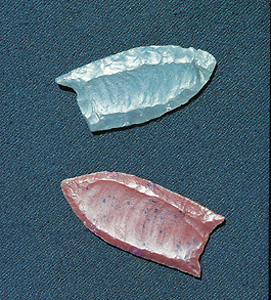Folsom point, a type of prehistoric spearhead, was the first evidence that human beings lived in North America during the Ice Age. A cowboy first discovered the stone points near Folsom, New Mexico, during the early 1900’s. In 1926, scientists found the spearheads mingled with the bones of an extinct species of bison and identified the points as prehistoric weapons. The ancient bison disappeared about 10,000 years ago, following the end of the last ice age. The discovery of weapons with the bison bones proved that people had migrated to North America by about 8000 B.C. Before the Folsom discovery, most scientists had believed that the first people came to the Americas more recently. Most scientists today think the spearheads are 10,000 to 11,000 years old. Researchers have also discovered Folsom points at other sites in New Mexico, Colorado, and Texas.

Folsom points differ from later spearheads in that they have a long, thin shape rather than a triangular one. The points also have a long flake removed down the center of one or both faces. The groove created by removing the flake is called a flute, and this type of stone point is called a fluted point.
See also Clovis culture.
